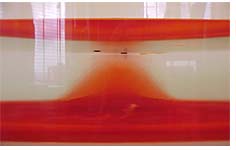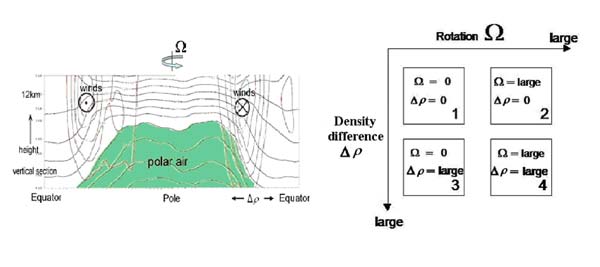Introduction | Tank – How to | Tank – Examples | Atmosphere – The Polar Front | Atmosphere – Synoptic Fronts | Theory | For Teachers | Wiki
An effective way of engaging students in to this project is to discuss four separate tank experiments, each with a different combination of rotation rate (zero and large) and density difference (zero and large). For this purpose you can download a pdf of the matrix here.
Encourage students to make predictions about what they expect to see (get them to discuss their predictions) before the experiments are performed.
Experiment 1: No rotation, no density gradient
With no rotation and no density difference, dyed water released from the central cylinder (see experimental details here) will mix in a turbulent manner with the clear ambient fluid.
Experiment 2: Rotation, no density gradient
With rotation and no density difference, the dyed fluid is initially in solid body rotation. On releasing the dyed fluid, Taylor columns can be seen and mixing occurs in the swirling, 2-d manner studied in the dye-stirring experiment described here.
 Experiment 3: No rotation, density gradient
Experiment 3: No rotation, density gradient
The dyed salty water falls under gravity and settles on the bottom. There is some mixing, but a well-defined interface can be seen which supports gravity wave undulations until relaxing back to the horizontal.
Experiment 4: Rotation, density gradient
The effects of both rotation and density gradients combine to support a frontal surface with a distinct slope, a useful analogue of an atmospheric front.
Atmospheric Climatology (more advanced)
Use NCEP-reanalysis climatology to verify thermal wind balance across the polar front:
- Plotting Activity – Plot and ftp your data (3 files total). See instructions.
- Thermal wind Activity – Download MATLAB script to compute the temperature gradient and vertical wind shear.
